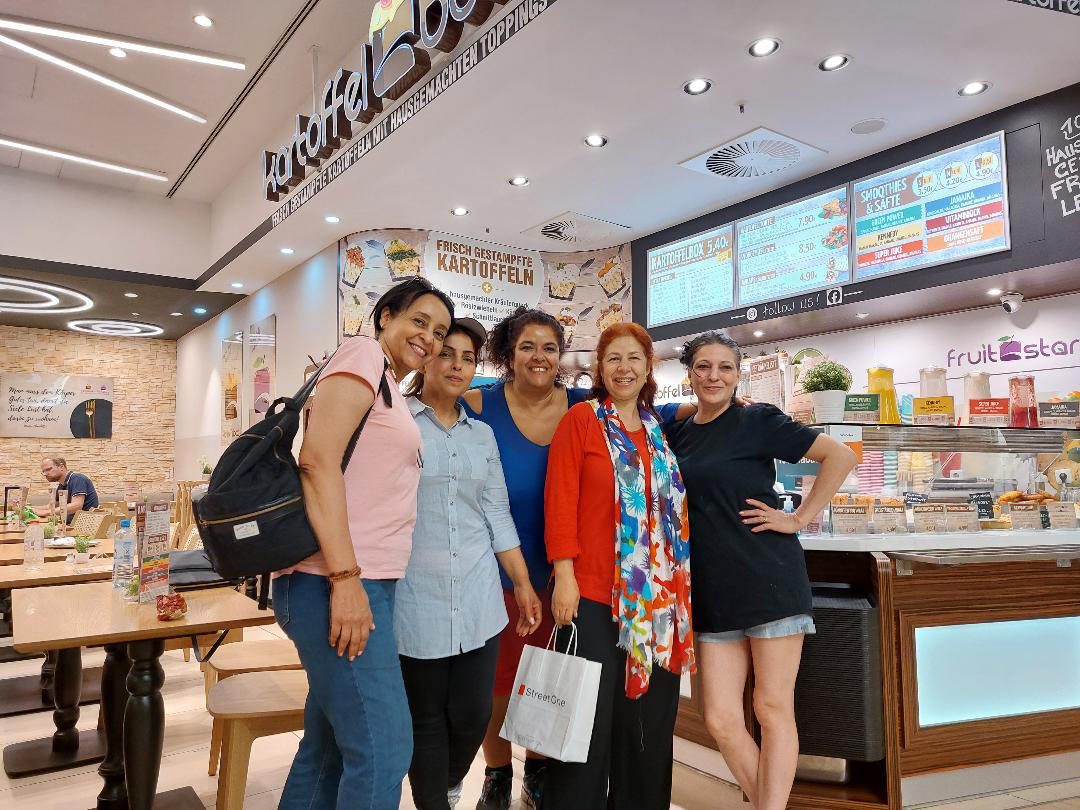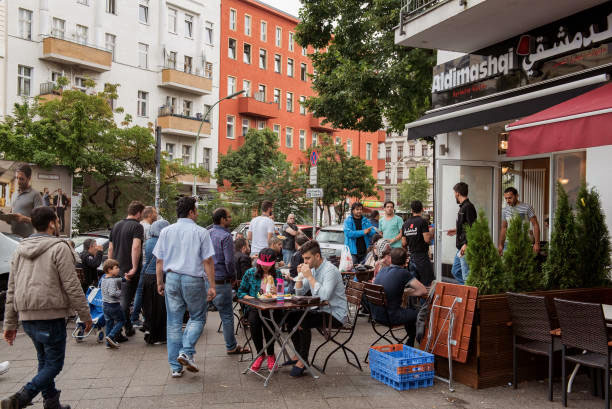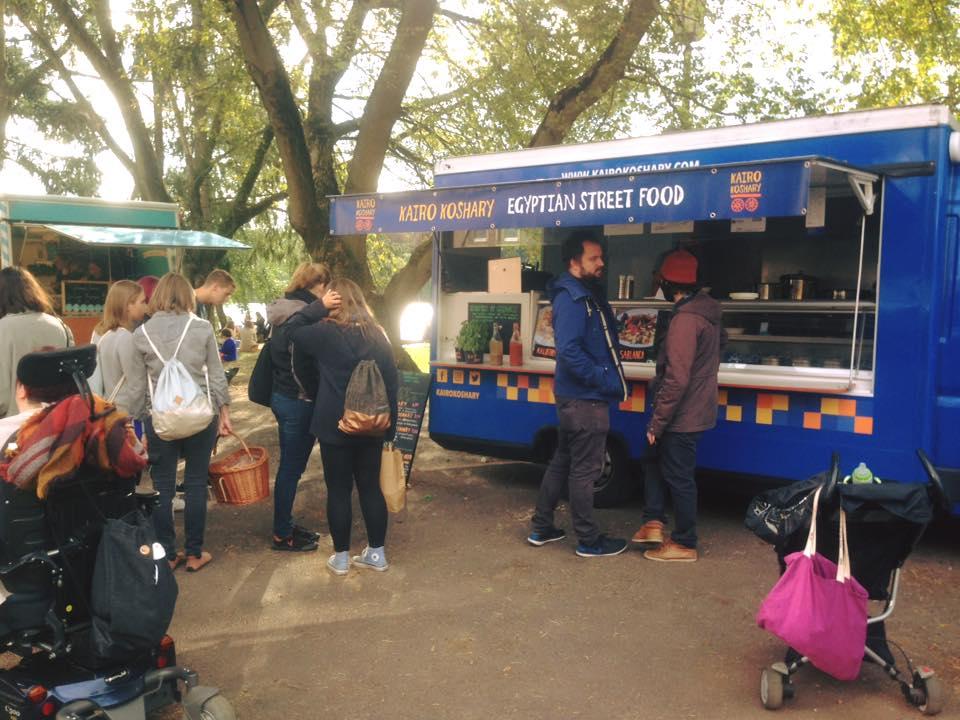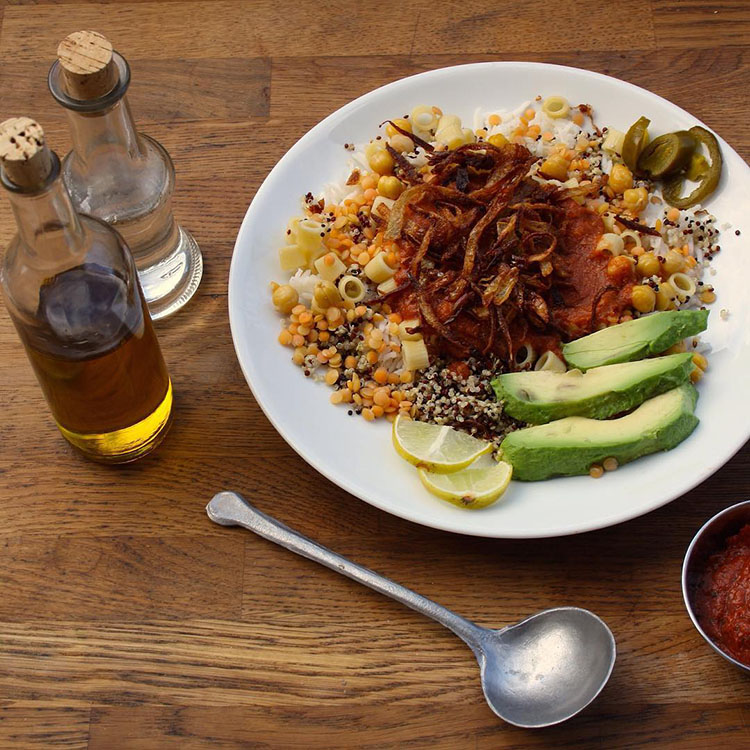
Randa Aboubakr
As we had agreed a couple of days earlier, I met Hoda and Nora at the suburban train station, Rathaus Spandau, on the northwest side of Berlin. We were heading to Altstadt Spandau to spend an entspannt (relaxed) late afternoon in the old town. I had been in Berlin for a couple of months for some work, and was about to return to Cairo, while Nora had been visiting for two weeks, and Hoda had moved from Cairo to Berlin nearly 25 years earlier.
It was around 18:30, and we briefly debated whether to grab a quick dinner at the station or walk to the old city and have a leisurely meal in one of the restaurants. Since I was already very hungry, I suggested that I get a bite to go and then see if I wanted to have some soup or salad with them in the city. Just as I was looking for a place where I could find something that was both vegetarian and gluten-free, I glimpsed an exquisite display of potato tarts (tortillas) in the display window of a small diner called Kartoffelbox. They were neat and colorful, and immediately toyed with my love for both potatoes and eggs. Using my broken German, I ordered a slice of the tomato tortilla zum mitnehmen (to take out), so that we could proceed on our way, and the cheerful shop attendant was nice enough to try to understand me. As she was preparing my order, Hoda and Nora were surveying the display, and apparently found it too enticing to resist. The three of us, thus, decided to stay and dine in. A bit embarrassed, I asked the nice lady (who had already packed my order, and was being helped by another woman) to change the order to hier essen (eat here), so that we could all sit and eat.
Just as I was trying to put some words together to make that request, I heard the two female shop attendants speak to each other in what I could identify as a Palestinian Arabic dialect. Encouraged, I now said that we wanted to dine-in in my Egyptian dialect. Right away, and as if she had expected that, the lady who had taken my order (who later introduced herself as Fatma) responded to my request, in fact mimicked my request, in an adorable and deliberately exaggerated Egyptian accent, while she carefully transferred the contents of the Styrofoam package onto a graceful dinner plate.
The lady’s reaction was not an unusual occurrence. During my frequent travels to Arab countries and encounters with non-Egyptian Arabs, I often meet those who take pains to imitate the Egyptian dialect when talking to me, something that is difficult for me to reciprocate, since I do not have a corresponding talent. Especially with women, this is also often accompanied by hand gestures and body language meant to reproduce the modes of Egyptian verbal practice. Though most of these are usually exaggerated, and mainly derived from popular Egyptian cultural productions, such as films, TV serials and songs, it always fascinates me that other Arabs are so much in contact with Egyptian culture. I find it endearing, and it warms my heart.
Fatma and Siham (the other shop assistant) were warm and welcoming, and the five of us instantly clicked, finding ourselves exchanging jokes and repartee across the narrow passage separating our table from the counter behind which they stood. Both women turned out to be Palestinian-Lebanese. Fatma, in particular, was highly jovial, and all the time she was doing her job, she sang softly in the Palestinian dialect. When I asked her if she had heard the latest Egyptian pop-hit “Sitto Ana” (My Queen(, she looked at me reproachingly and went straight into the kitchen, which opened onto the diner, and blasted the song on her mobile phone. She came back dancing and chanting at a high pitch. Siham joined in, and then the three of us did the same. The whole scene was joyful, lively, and invigorating.
Reflecting on the incident with Hoda and Nora a couple of days later, we all seemed to sense something richly symbolic about five Arab women singing and dancing at a diner for Spanish specialties in a Berlin municipality. We also all felt that the whole encounter was genuinely friendly, and even had a touch of magic. On a certain level, the five of us connected deeply.
I have been regularly coming to Germany (especially Berlin) for research purposes for two decades, and some of my stays have lasted for one or two years. What struck me most upon my first arrival in Berlin in 2002 was how the city was open to so many cultures, and how active it was in establishing and maintaining bridges between them. In fact, the very first literary event I remember attending in Berlin that year was a session organized by Haus der Kulturen der Welt (House of World Cultures), hosting two of the most eminent, and in a sense “competing” Arab poets then living — Mahmoud Darwish and Adonis. At the time, I could not imagine such a session was possible to organize at all, let alone in a non-Arabic-speaking country where the two poets were less known and hardly celebrated. As I lived longer in Berlin and got to know the cultural scene more closely, I came to realize that the “multi-kulti” approach, exemplified by the aforementioned literary event, was a reflection of what the city was capable of in the cultural domain. And throughout my subsequent visits, Berlin never failed to surprise me with its ability to bring together people and events from various cultural backgrounds.

The presence of Arabs in the city, on a more mundane level, was also clear and distinct for me, popularly exemplified by the renowned Sonnenallee, now famously known as Shari` al-`Arab (Arab Street), even, I was told, on Google maps. How the avenue (and the district of Neukölln at large) expands every time I visit Berlin gives me a small indication of how Arab presence in the city also does. The Berlin friends I talk to about Sonnenallee often have mixed feelings about it, with some seeing it positively, as a manifestation of the multiculturality of the city, others viewing it as a “ghetto” where a “minority” shelters itself, and yet others standing in between these two polar positions. I would not, of course, be able to determine whether what I witness in Sonnenallee reflects meaningful “integration.” That’s why I usually veer away from using that term. Whether the Arabs who throng the famous avenue were, or felt, integrated is something I am not fit to determine.
But what I can speak about with a little more confidence is how Arab cuisine seems to be effortlessly integrated in Sonnenallee’s culinary scene (and by extension that of Berlin at large). On my first arrival in Berlin, there were many, predominantly Turkish, döner shops and Imbisse (snack joints) that sold the delicious, aromatic shawarma or falafel pockets, which entrapped me instantly. Occasionally, I would find a Palestinian or Egyptian shawarma and falafel shop. Yet Arab and Middle Eastern shops in Sonnenallee itself were few and confined to a narrow stretch of the street. Food shops, back in 2002-2003, were not that numerous, and what was more predominant was the presence of clothing stores, goldsmiths’ shops, travel agencies, and other services. With every renewed visit, I would watch the Arab part of the street visibly expand. Concomitantly, the growing presence of food shops was increasingly visible (especially as of 2015), whether grocers who sold Lebensmittel, (food products), some of which came directly from the shelves of Egyptian or Syrian supermarkets (such as dried chickpeas, raw bulgur, and frozen jute mallow and taro), or eateries that served aromatic and flavorful Arabic food staples (such as falafel, mhammara, hummus, and mutabbal dips).
It was also around the same time that a wide array of pastry shops could be seen dotting Sonnenallee. One of these sweet-treat shops offered the most delicious Syrian confection, and thus became my prime destination. I would head to Damaskus right after my arrival in Berlin, whether on a short or long visit, and indulge in a tiny plate of fresh halwait al-jibn, or warm and stretchy knefeh nabulsiyya.
Yet, those who are familiar with Sonnenallee know that the food shops and restaurants bulging onto the pavements there are not exclusively frequented by Arabs, just like your average Döner Imbiss anywhere in the city is often bustling with Germans and members of other nationalities at lunchtime. The Arab and Middle Eastern cuisine, like a few other ethnic cuisines, has become an integral part of the food scene in the city. One of the reasons behind this appeal is most probably the fact that these cuisines lend themselves easily to vegetarian and vegan lifestyles, which one can easily tell are on the rise among (young) Berliners. From falafel, the quintessential vegetarian burger, to hummus paste, baba ganouj, fattet hummus, and rice-stuffed vine-leaves, the offers are as delectable as they are günstig (affordable).
In Egypt and a large part of the eastern Arab region, falafel is the number-one breakfast sandwich. It does not matter much that we mostly call it ta`miyya in Egypt, and that we prepare it primarily with a lot of fresh parsley and coriander, and with split fava beans rather than chickpeas. It is still the same fluffy discs, deep fried in oil, tossed into half pitas, and topped with green salad and tahini sauce to make an irresistible warm sandwich. Alongside this breakfast staple in Egypt comes ful midammis, that is, slow-baked fava beans, seasoned with cumin and a few drops of olive oil or a squeeze of half a lemon. Though ful midammis is as popular as falafel in terms of breakfast food in these parts of the Arab region, you can see that it did not make its way into the array of lunch food in Berlin as widely as the crunchy falafel. The only reason I can think of is that ful midammis does not behave well as a sandwich. Unlike the neat and crispy discs of falafel, ful midammis is a mushy kind of stew, and would render the toughest of bread soggy in no time. That would be a mess a German on a quick lunch break would not want, though is perfectly fine for an Egyptian or a Jordanian having breakfast in a small cafeteria or at a street food cart, and, rather than attempting a sandwich, actually consuming the meal in large dips of bread.

One other particularly Egyptian food that tried to make its way into the Berlin culinary scene is koshary, a curious mixture of lentils, vermicelli rice, ditalini pasta, chickpeas, caramelized onions, and several kinds of sauce. It was also around 2015 that I heard of a small restaurant offering koshary in the posh Berlin Savignyplatz. Though the place carried the name of a famous Egyptian koshary spot, it actually offered a variety of Egyptian and North African foods. And though I found the koshary served there both mushy and bland, I could see that it was in high demand, particularly among the restaurant’s German customers. Koshary is vegetarian, filling, nutritious, and very reasonably priced. However, it does not seem to have impressed other Berliners that much, judging by the fact that we have not yet seen it served widely across the city. This may be because it is a heavier meal than falafel, and one packed with a little too many carbs.
There was an attempt during the past few years to introduce koshary to the wider Berlin culinary scene through a mobile food cart called Kairo Koshary, which would pop up during street festivals and other open-air events, offering not only the Egyptian standard version of the dish, but also a couple of modified varieties. Koshary is among my absolute favorite Egyptian foods, and I seek it out wherever it is served. That’s why I used to check the schedule of this koshary truck whenever I was in Berlin; I wanted to make sure I was not missing out on anything. Theirs was actually a finer version of koshary than the one offered at Savignyplatz, but what was more interesting for me was the two additional varieties of koshary with a twist that the proprietors of the truck had developed. One of them was Moroccan/Casablancan koshary, with couscous instead of rice, and a topping of almonds, dried dates, and raisins, and the other was American/Californian koshary which featured quinoa in place of rice, and a topping of sliced avocado. I did not actually like either variety, but for me they represented creative attempts to adapt the dish to various tastes, among Arabs and non-Arabs alike.

How falafel was chosen over ful midammis and how koshary enthusiasts sought to widen its popularity in Berlin was to me emblematic of culinary integration in the sense I prefer to conceive of the term “integration.” It is not just the tweaks and adaptations the food undergoes in order to be made more appealing to local taste and hence establish itself as part of the cultural make-up of the city. Integration, in its various manifestations, is a two-way traffic. Adjusting your norms to the host culture so as to gain access is only part of the process. The host culture, in its turn, adjusts itself to have you as part of it. The least that can be done is to accept and make room, just as with several Arab and Middle Eastern dishes that were enabled to become integral parts of the Berlin scene, and are now cherished by the local community. If the food is allowed to establish a presence for itself, it becomes an actor and a catalyst, effortlessly and seamlessly.
Despite the fact that the borders between food cultures are flimsy and porous, and that historical processes of cross-fertilization render it difficult to speak with certainty about the “origin” and “nationality” of a particular dish, food remains among the most authentic markers of cultural identity, especially in contexts of power imbalance, in addition to the role it plays in developing and sustaining human relations. One can also see the food shops dotting Sonnenallee and other Berlin districts, especially with their Arabic names written in bold Arabic characters, as emphasizing ethnic presence, and claiming urban symbolic capital in an exceedingly diverse context. But there is more to this visual presence. It also says: We are here, and we are contributing to the life of the city.
That brief encounter at the Spandau diner left me wondering about a lot of things. One was the quick and easy connection we, the five participants in that event, formed, which I thought was not only the result of a shared cultural background, but also partly due to the fact that we were all women, bonded through processes of food-making, food consumption, and song. This also invited reflections on how such cultural practices connected people on a more general level. There was also how the scene at this small diner reflected the growing Arab (and other Middle Eastern) presence in Berlin. I was, likewise, intrigued by how Fatma’s uncommon behavior of spirited dancing and loud singing on the job contrasted with what I had been accustomed to with regard to German dining services, and consequently, how Fatma and Siham’s spontaneous dancing and chanting in the diner might change the expectations of Berlin customers about the “norms” of good restaurant service, even if just a little bit. And, finally, there was how all of that was arguably changing how Berlin looked and behaved. Another manifestation of “integration” for me, one it may well be ambitious to hope for, is that one day, a good-humored Berliner who comes in for a snack will join in with the singing and dancing.



